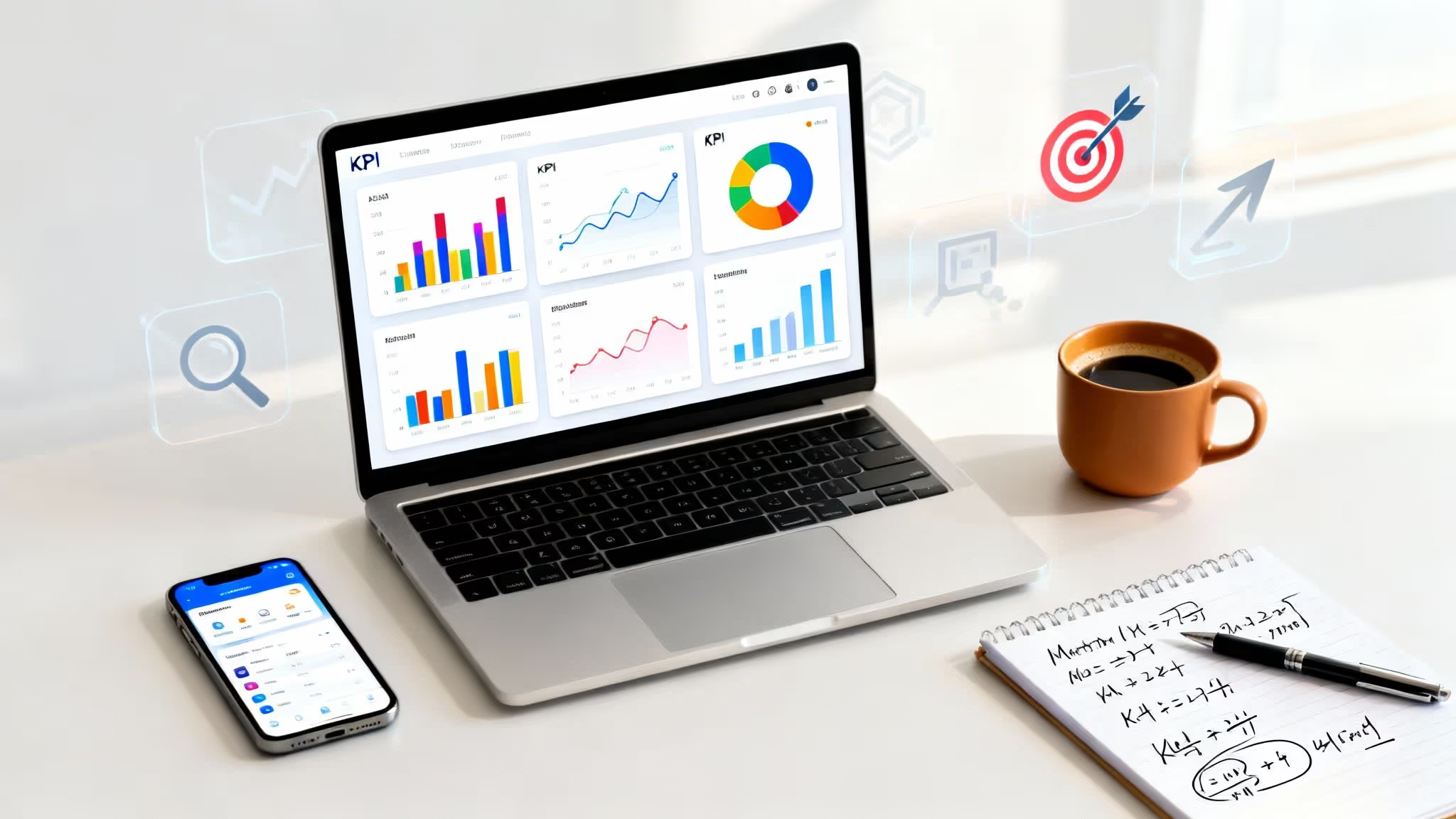A powerful B2B SaaS marketing strategy is more than a series of campaigns; it’s the engine that drives long-term growth. The objective is to move beyond vanity metrics and build a system that attracts, engages, and retains high-value accounts through intelligent, data-backed decisions. This approach ensures every dollar spent is an investment in a predictable and sustainable business.
Building Your Unshakeable Marketing Foundation
Before launching an ad or publishing a blog post, the foundational work must be done. A winning B2B SaaS marketing strategy isn't built on tactics—it's built on a deep, almost obsessive, understanding of your ideal customer. This initial stage is about creating a precise blueprint that guides every subsequent marketing decision.
Think of it as building a house. You wouldn't choose furniture before finalizing the architectural plans. Rushing this part leads to expensive mistakes and a wobbly structure that can’t support real growth. Marketing without this groundwork is just pricey guesswork.
To begin, let's establish the essential pillars that will support your entire strategy. These are the non-negotiables for building a marketing machine that delivers results.
The table below outlines the key foundational pillars you need to establish.
Key Foundational Pillars of a B2B SaaS Strategy
Establishing these pillars ensures your marketing is targeted, relevant, and resonates with the right audience from day one.
Define Your Ideal Customer Profile
First, you need to move beyond vague descriptions to create a razor-sharp Ideal Customer Profile (ICP). An ICP isn't just a list of demographics; it's a detailed picture of the perfect-fit company for your product. You're identifying organizations that will gain the most value from your solution and, in turn, provide the most value back to you.
To build a robust ICP, focus on specific firmographic data points:
- Industry or Vertical: Which sectors feel the pain you solve most intensely? Get specific.
- Company Size: Are you targeting scrappy startups with 10-50 employees or enterprises with over 1,000?
- Annual Revenue: What revenue range signals a company can afford your solution and has a genuine need for it?
- Technology Stack: What other software do they use? This can reveal integration opportunities and signal tech maturity.
Map Out Buyer Personas Within Your ICP
Once you know the companies you're targeting, you need to understand the people inside them who influence purchasing decisions. This is where buyer personas are critical. For any ICP, you will likely engage several key personas, such as the daily End-User, the gatekeeping IT Manager, and the budget-holding C-Level Executive.
For each persona, you must dig deep. Uncover their genuine pain points, what their daily work entails, and what triggers a purchase decision. What challenges keep them up at night? What does a "win" look like in their role? Answering these questions transforms your marketing from generic noise into a specific, compelling solution.
Conduct Competitive Intelligence
With a clear picture of your customer, it's time to analyze the competition. This isn't about copying rivals; it’s about spotting gaps in the market where your solution can truly shine.
A thorough competitive analysis reveals how others position themselves and where their messaging falls short. This process is essential for crafting a unique value proposition that makes you stand out. A clear grasp of these dynamics is also vital for improving B2B marketing and sales alignment, ensuring both teams operate from the same strategic playbook.
The global B2B SaaS market is projected to hit $344 billion by 2027, highlighting both the massive opportunity and the fierce competition. Success in this crowded space demands a multi-channel strategy built on a rock-solid foundation of customer and market intelligence. This foundational work ensures every marketing action is precise, impactful, and designed for growth from the start.
Mastering Content and SEO to Win Your Niche
In the competitive world of B2B SaaS, content isn't a side project—it’s the core of how you build authority and earn trust. An effective marketing strategy hinges on becoming the undisputed, go-to resource for your ideal customer. It's about creating a content engine that pulls in qualified leads by relentlessly answering their biggest questions.
This is more than just churning out blog posts. It's about building a strategic arsenal of high-value assets that guide prospects through their entire decision-making process. The goal is simple: be seen as a thought leader, not just another vendor.

Building Your Content Arsenal
To truly own your niche, you can't rely on a single format. Different assets serve different needs and appeal to different personas. A solid content plan requires variety to engage potential customers at every stage of their journey.
Think of your content as a library of solutions. Some people are just browsing and want a quick article. Others are ready for a deep dive into a complex problem. Your job is to have the right resource waiting for them.
Here are a few essential content types to get you started:
- In-Depth Blog Posts: The foundation of your SEO efforts, these should target specific customer problems and be packed with practical, well-researched advice.
- Comprehensive White Papers: For prospects seriously considering their options, a white paper offers a deep, data-backed look at a major industry challenge, framing your product as the solution.
- Data-Driven Case Studies: Nothing demonstrates value better than real-world proof. Case studies showcase your product's impact with hard numbers and success stories from actual customers.
- Engaging Webinars: Live or on-demand, webinars provide a direct line to your audience, allowing you to showcase expertise, answer questions, and build a genuine connection.
By blending these formats, you create a powerful resource hub that captures attention from the early "awareness" stage all the way to the final "decision" stage.
Demystifying SEO with Topic Clusters
Excellent content is useless if no one can find it. That’s where a smart approach to Search Engine Optimization (SEO) comes in. Forget chasing random keywords. Modern B2B SaaS marketing is about organizing content into topic clusters.
Imagine your core service as the sun. The topic cluster model involves creating a comprehensive, authoritative "pillar page" on that central topic. You then surround it with smaller "cluster" articles that explore related subtopics in detail.
This structure does more than just organize your content. It signals to search engines like Google that you are an authority on a subject. By linking all cluster pages back to the main pillar page, you create a powerful network of expertise that boosts your rankings for a whole range of related keywords.
For instance, a project management SaaS could create a pillar page on "Agile Project Management." Its cluster content might include articles like "How to Run an Effective Sprint Planning Meeting," "Best Practices for Kanban Boards," and "Scrum vs. Kanban: Which Is Right for Your Team?"
Capturing Buyer Intent with Keyword Research
The bedrock of any effective SEO strategy is keyword research that goes beyond search volume. You must uncover the exact words and phrases your ideal customers use when actively looking for a solution. This comes down to understanding buyer intent.
There are three primary types of intent to focus on:
- Informational: The user is seeking an answer (e.g., "what is customer relationship management"). These are perfect for your top-of-funnel blog posts.
- Navigational: The user is trying to find a specific site (e.g., "Salesforce login"). These are less critical for attracting new customers.
- Transactional: The user is ready to buy or take action (e.g., "best CRM for small business"). These are gold mines for landing pages and product comparisons.
When you map your keywords to each stage of the buyer's journey, your content appears at the perfect time. This strategic approach to B2B search engine optimization transforms your website from a simple brochure into a lead-generating machine that works for you 24/7.
Using AI for Smarter Marketing and Personalization
Artificial intelligence is no longer a futuristic concept; it has graduated from a buzzword to a must-have tool in every serious B2B SaaS marketer's toolkit. This isn’t about replacing your team with robots. It’s about giving them a super-powered assistant that amplifies their efforts, uncovers game-changing insights, and forges customer connections at scale.
For many, the easiest entry point is generative AI. It serves as a tireless brainstorming partner, capable of generating hundreds of blog ideas, mapping out content strategies, or drafting social media posts in minutes. This frees up your team to focus on high-level strategy and adding that crucial human polish.
However, the real power of AI lies in deep analysis. It can process vast amounts of customer data—from support tickets to product usage logs—and spot patterns invisible to the human eye. This data-driven approach helps you understand what customers actually want, leading to messaging and product updates that truly resonate.
Personalization at Scale
Beyond content creation, AI's most profound impact is on delivering true one-to-one personalization. The old method was basic, like inserting a first name into a generic email. Today, AI-powered personalization can dynamically reshape the entire customer journey based on real-time behavior.
Machine learning algorithms analyze a user's clicks, content downloads, and feature usage to instantly customize their experience. This allows you to create a more human and relevant journey for every individual who interacts with your brand.
- Tailored Website Experiences: AI can modify website content on the fly. A visitor from the finance industry might see a case study about banking, while someone from healthcare sees a more relevant example.
- Hyper-Relevant Email Campaigns: Forget generic email blasts. AI can trigger campaigns based on specific user actions, ensuring the right message arrives at the precise moment it’s needed most.
- Optimized Ad Spend: AI algorithms monitor ad performance 24/7, automatically shifting your budget to the campaigns and audiences delivering the best results, maximizing every dollar.
Integrating AI into Your Workflow
You don't need a team of data scientists to begin. Start small by pinpointing a specific pain point in your process and applying the right tool. For example, use an AI tool to sift through sales call transcripts, identify common customer objections, and then use that intelligence to craft more effective marketing content.
The data confirms this is no longer optional. Recent studies show 81% of B2B marketers now use generative AI tools, a significant increase from 72% the previous year. Furthermore, 64% of SaaS companies have integrated AI into their marketing, with many promoting AI-powered features as a key selling point.
The goal isn't just to use AI; it's to use it strategically. It’s about creating efficiencies and delivering a level of personalization that was previously impossible. This frees your team from repetitive tasks to focus on the strategic work that drives growth.
A great way to start is by exploring existing tools. Many platforms are user-friendly and integrate directly into your current marketing stack. To help, check out our guide on the 12 best AI tools for digital marketing. It’s a practical overview of excellent options for SEO, content creation, and analytics.
Ultimately, any modern B2B SaaS marketing strategy must include AI—not just for efficiency, but for effectiveness. By automating mundane tasks and unlocking deeper customer insights, you can build a more personal, responsive, and impactful marketing engine that stands out.
Choosing Your Core Customer Acquisition Channels
A brilliant B2B SaaS marketing strategy with the perfect message is useless until it reaches the right audience. Choosing the right customer acquisition channels is like selecting the right tools for a job. You wouldn't use a hammer on a screw. The goal is to build a diversified, resilient mix of channels that fits your growth stage, budget, and ideal customer.
This isn't about jumping on the latest trend; it's a strategic process. You need to determine where your ideal customers spend their time and what messages will grab their attention at the exact moment they need a solution.
Mapping out how your content will be distributed across different channels is an excellent way to ensure they all work together cohesively.

This organized approach ensures your efforts are coordinated and purposeful, not scattered and reactive.
High-Intent Performance Marketing
Performance marketing channels are designed to capture demand from people who are actively searching for a solution. Take Google Ads, for instance. It’s like setting up a digital storefront on the busiest street in the world. When someone searches for a term like "best CRM for marketing agencies," you want your ad to be the very first thing they see.
These channels are powerful because they target users with high buyer intent. The challenge? They can be expensive, and competition is fierce. Success requires meticulous keyword research, compelling ad copy, and landing pages that convert visitors into leads or trials. It's a direct, measurable path to growth but demands constant optimization to maintain a profitable Customer Acquisition Cost (CAC).
Precision Targeting with Social Ads
While Google captures active searchers, platforms like LinkedIn Ads allow you to get in front of specific professionals before they even begin their search. This is where a crystal-clear Ideal Customer Profile (ICP) and detailed buyer personas provide immense value.
With LinkedIn, you can target users by:
- Job Title: Reach "Chief Financial Officers" or "VPs of Engineering" directly.
- Industry: Focus on sectors like "Financial Services" or "Healthcare Technology."
- Company Size: Limit your audience to companies with 50-200 employees.
- Specific Companies: Upload a curated list of your target accounts.
This precision makes it the perfect channel for account-based marketing (ABM) campaigns or for promoting high-value content like white papers to a niche audience. It’s less about capturing existing demand and more about creating it. For a deeper dive, our guide on effective B2B digital marketing strategies offers more insights on leveraging these platforms.
To help you decide where to start, here's a quick comparison of popular B2B SaaS acquisition channels.
B2B SaaS Acquisition Channel Comparison
Each channel has its place, and the most effective strategies often blend several to create a balanced marketing engine.
Building Sustainable Growth Loops
Relying solely on paid advertising is a risky strategy. A truly resilient B2B SaaS marketing strategy builds channels that create long-term, sustainable growth loops—systems where your current efforts generate compounding returns over time.
A growth loop isn't just a marketing tactic; it's a self-reinforcing system. Consider how Dropbox grew by offering users extra storage for referring friends. Each new user became a potential advocate, creating a cycle of organic growth that didn't rely on ad spend.
Here are a few powerful growth loops ideal for B2B SaaS:
- Partner Marketing: Collaborate with non-competitive companies serving the same ICP. This could involve co-hosting webinars, writing guest posts for each other, or establishing a referral program, giving you instant access to a warm, relevant audience.
- Community Building: Create a dedicated space—like a Slack group or private forum—where your users and industry peers can connect. A thriving community boosts loyalty, reduces churn, and becomes an invaluable source of product feedback and user-generated content.
- Strategic Integrations: Building integrations with other tools your customers already use is a massive acquisition channel. When a user of another platform sees your product in their integration marketplace, it serves as a trusted endorsement and provides a direct path to your solution.
By combining high-intent paid channels with these sustainable growth loops, you create a marketing engine that’s powerful today and resilient tomorrow. This balanced approach drives immediate results while building a brand with a durable competitive advantage.
Measuring What Matters to Drive Sustainable Growth
Marketing without measurement is just expensive guesswork. In B2B SaaS, every dollar spent and every action taken must be tied to a clear, measurable outcome. While it's easy to get lost in a sea of data, the companies that achieve explosive growth focus on a handful of core metrics.
This isn't about pulling numbers for a report. It's about creating a tight feedback loop where today’s insights directly sharpen tomorrow’s strategy.
Think of your marketing dashboard like an airplane's cockpit. You don’t need to monitor every single gauge, but a few critical instruments tell you if you're on course, gaining altitude, and have enough fuel to reach your destination. For a SaaS business, those instruments are the metrics that reveal the true story of your company's health.

Core SaaS Metrics You Cannot Ignore
To build a sustainable growth engine, you must look past vanity metrics like social media likes and zero in on the numbers that directly impact the bottom line. These KPIs are interconnected, and together, they paint a complete picture of your performance.
Here are the foundational metrics every B2B SaaS marketer must master:
- Monthly Recurring Revenue (MRR): The lifeblood of any subscription business, MRR represents the predictable revenue you can count on each month. Tracking its growth is the clearest indicator of your company's momentum.
- Customer Acquisition Cost (CAC): This metric tells you exactly how much you spend, on average, to acquire a new paying customer. It's calculated by dividing your total sales and marketing expenses over a period by the number of new customers acquired in that same period.
- Customer Lifetime Value (LTV): LTV is the total revenue you can expect from a single customer throughout their entire relationship with your company. A high LTV means you’re not just acquiring customers—you’re acquiring valuable customers who stay.
Understanding each metric is a start, but their true power is unleashed when you analyze how they relate to one another.
The Golden Ratio: LTV to CAC
The most critical relationship to track is between a customer's value and the cost to acquire them. The LTV to CAC ratio is the ultimate report card for your marketing and sales efficiency.
A healthy B2B SaaS business typically aims for an LTV to CAC ratio of 3:1 or higher. This means for every dollar invested in acquiring a customer, you can expect to get at least three dollars back over their lifetime.
If your ratio is too low, such as 1:1, you're essentially breaking even on each customer, leaving no room for profit. Conversely, if it's excessively high, like 8:1, it might indicate you're underinvesting in marketing and could be growing much faster.
Understanding Your Payback Period
Another metric tied directly to cash flow is the CAC Payback Period. This tells you how many months it takes to earn back the money spent to acquire a customer. In the capital-intensive SaaS world, a shorter payback period means you can reinvest that cash into growth initiatives more quickly.
For most B2B SaaS companies, a payback period of under 12 months is considered excellent. This financial discipline ensures your growth is sustainable in practice, not just impressive on paper. For a deeper look, you can explore our guide on the most important digital marketing performance metrics to track.
By constantly monitoring these core metrics, you create a powerful cycle of improvement. You can confidently double down on channels delivering a low CAC and a high LTV while pulling back from campaigns that aren't providing a healthy return. This data-driven approach transforms your B2B SaaS marketing strategy into a predictable, scalable, and profitable growth machine.
A Few Common SaaS Marketing Questions Answered
When you're deep in the trenches of building a B2B SaaS marketing strategy, the same questions tend to surface repeatedly. Let's tackle some of the most common hurdles and clear up the confusion many marketers face.
How Long Does It Take to See Results?
This is a crucial question, and the answer depends on your chosen channels. If you need leads immediately, a well-tuned Google Ads campaign can generate activity within days—but you'll pay a premium for that speed.
Conversely, channels like content marketing and SEO are a long-term investment. Think of it as planting a tree, not flipping a switch. You can expect to see a significant impact on organic traffic and leads after 6 to 12 months of consistent, high-quality content creation. The benefit is that this work compounds over time, creating a valuable asset that continues generating leads for years.
How Much Should a B2B SaaS Company Budget for Marketing?
There is no single magic number. A common benchmark for growth-stage SaaS companies is to allocate 20-40% of Annual Recurring Revenue (ARR) to sales and marketing. Early-stage startups often invest even more aggressively to establish a market foothold.
A more practical approach is to work backward from your revenue goals:
- First, determine your target for new Monthly Recurring Revenue (MRR).
- Next, calculate how many new customers are needed to hit that target.
- Based on your lead-to-customer conversion rate, determine the number of leads required.
- Finally, use your average cost-per-lead (CPL) across different channels to build your budget from the ground up.
This method anchors your spending to tangible business outcomes rather than an arbitrary percentage.
Which Marketing Channels Should We Prioritize First?
When starting to build your B2B SaaS marketing strategy, always begin at the bottom of the funnel. Focus on capturing prospects who already have a problem and are actively searching for a solution like yours.
Your first priority should be to win customers who are already searching for you or your competitors. Only after effectively capturing this existing demand should you move up the funnel to create new demand through broader awareness campaigns.
This means prioritizing:
- Google Ads: Target high-intent, transactional keywords like "[Your Competitor] alternatives" or "best [Your Solution Type] software."
- Comparison and "Vs" Pages: Create dedicated landing pages that directly compare your product against the competition. This is precisely the content people seek in the final stages of their decision-making process.
Once these channels are optimized, you can expand into mid-funnel activities and broader top-of-funnel channels, like LinkedIn Ads or thought leadership content.
What Is the Most Common Mistake in SaaS Marketing?
The single biggest mistake is becoming obsessed with product features instead of focusing on customer problems. It's easy to fall into the trap of talking about what your software does, but customers only care about why it matters to them.
No one is impressed by your new AI-powered algorithm. They care about saving an hour each day, cutting operational costs, or eliminating a major headache in their workflow.
Every piece of your marketing—from homepage copy to ad campaigns—must answer the customer's silent question: "What's in it for me?" A winning B2B SaaS marketing strategy is built on a deep, empathetic understanding of customer pain points, not just a list of technical specifications.
At Twelverays, we specialize in crafting data-driven digital marketing strategies that move beyond guesswork to deliver measurable growth. If you're ready to build a marketing engine that drives real results, let's connect. Learn more about our approach at https://twelverays.agency.





